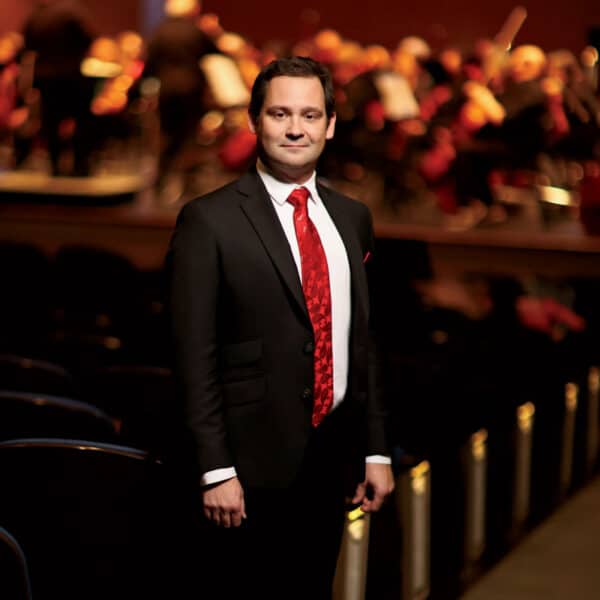TIMELESS MASTERPIECE
By Thomas Connors
PHOTOGRAPHY BY IAN MCLEOD
STYLING BY THERESA DEMARIA
Music director, Chris Ramaekers
By Thomas Connors
PHOTOGRAPHY BY IAN MCLEOD
STYLING BY THERESA DEMARIA
Music director, Chris Ramaekers

When or—if—King George II stood up upon hearing the “Hallelujah” chorus at the premiere of Handel’s “Messiah” in 1743, was it because he was moved, or had a cramp? We’ll never know.
Likewise, when Beethoven premiered his Ninth Symphony in Vienna, we cannot be sure if the nearly deaf composer turned around to see a cheering audience at the conclusion of the “Ode to Joy,” or earlier, at the end of the second movement scherzo.
What’s for sure is that both compositions remain for general audiences among the most recognizable classical music pieces ever. So how fitting, now that the traditional holiday performances of “Messiah” are over, the Lake Forest Civic Orchestra is turning its attention to Beethoven’s final symphonic work with a January 19 performance at the James Lumber Performing Arts Center in Grayslake.
Performed under music director, Christopher Ramaekers, in collaboration with Chicago Master Singers, Lux Cantorum Chicago, community members, and chorus master John Hughes, the Ninth Symphony is a significant undertaking for the orchestra.
“Once we had made the decision to move forward, there were a number of activities that we needed to take on that were not part of our normal concert preparation,” says Nancy Otto, who serves as project manager for this program. “First, we had to find a venue with a workable date and a stage that was big enough to handle 150-plus personnel. Second, we needed to find singers, resulting in a collaboration with Chicago Master Singers and Lux Cantorum Chicago. As a community orchestra, it is part of our mission to bring the orchestra to the community, and the community to the orchestra. In the past, we have collaborated with local schools, featured student soloists, and played music by local composers. For this project, we extended an invitation to experienced volunteer singers in our area to join in our performance and increase the community involvement.”
In its 36 years, Lake Forest Civic Orchestra has never performed this piece. Most of its members have not either. The piece is a first for Ramaekers, too. Although he has conducted all of Beethoven’s other symphonies, this is the first time he’s tackled the Ninth.
“To prepare both the orchestra and me to take on this work, I began our season with Beethoven’s No. 1. Seeing where he started, and having worked on all his other symphonies, gives an insight into where he was going and what he was thinking. What about the second symphony is different from the first? Or how is the fourth different from the sixth?” he explains. “By putting this massive piece into the context of his entire catalog and knowing where it was coming from, I like to think that I have developed some idea of where Beethoven was going and what his goals with this piece were.”
Choral director John Hughes has sung in the work twice, but this is first time leading others through it.
“Many, if not most, of the participating singers, have sung this previously, so, learning the piece is not an obstacle,” says Hughes. “The main challenge is vocal fatigue. The vocal ranges are famously— or infamously—high, especially for the sopranos and tenors. I will certainly take this into account in rehearsal and will encourage the singers to pace themselves during the performance.”
Arguably, the key singularity of Beethoven’s Ninth is its choral component. Prior to its composition, notes Hughes, choral-orchestral works were primarily limited to Masses and oratorios. But like his predecessors, Mozart and Hayden, who had expanded the symphonic format from a short piece for a handful of musicians to something longer for a larger instrumental ensemble, Beethoven had been tweaking the form for years.
“By the time he gets to the Ninth, this genre expanded to the hour-plus-long work that we know today involving over 100 people, incorporating a chorus with a huge emotional range, and expressing some rather expansive ideas, both philosophical and social,” observes Ramaekers. “This symphony was not only a revolution itself; it was a capstone of a series of revolutions that Beethoven made within the genre. Without Beethoven’s symphonies, I don’t know that the expansive works of Mahler, Bruckner, Brahms, Shostakovich would have been possible.”
Or, as the 19th-century Russian revolutionary, Mikhail Bakunin, asserted, “Everything will pass and the world will perish but the Ninth will remain.”
For more information about The Lake Forest Civic Orchestra and to purchase tickets for Ode to Joy: Beethoven’s Symphony No. 9, visit lakeforestcivicorchestra.org.
Sign Up for the JWC Media Email